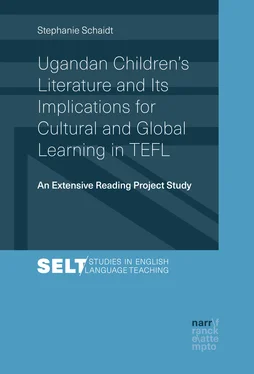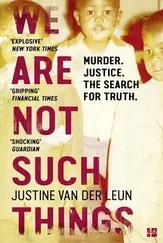The final questionnaire (see Appendices C and D) was completed after the reading project. In this questionnaire, students were asked to reflect upon the reading project and the books they had read. They were encouraged to suggest improvements for the extensive reading project and to elaborate on the narrative text they liked the best or disliked the most.
Questionnaires were used in this study because they are target-oriented and economical in terms of time. Given time-constraints it would not have been possible to interview all the students who participated in the extensive reading study before and after the study. Questionnaires make it “possible to get a range of responses from many people on a limited number of items” (Nunan & Bailey, 2009, p. 319). In my study, they permitted insights into the prior knowledge, expectations and reflections of all 45 students. Furthermore, responses in questionnaires are often more honest and authentic than in interviews and thus more reliable. As Cohen et al. (2011, p. 395) state, “the lack of face-to-face contact between the researcher and the respondents in a questionnaire might facilitate responses to sensitive material”. Another argument in favour of questionnaires is that when they are used with interviews, the two research instruments complement one another very well.
You may sometimes wish to employ a research design in which you first use questionnaires to get a broad cross section of information or opinions. You could subsequently use interviews to get more detailed data from a subgroup of your sample. (Nunan & Bailey, 2009, p. 319)
After collecting data through questionnaires and reading diaries, I made use of the “sample-resample procedure” (Nunan & Bailey, 2009, p. 319) and interviewed 24 of the 45 participants in the study to get more detailed information concerning the subject matter from them.
There are two major problems researchers face when using questionnaires in a study. First of all, even questionnaires with predominantly open questions can only ask for a limited amount of information. Participants cannot explain their thoughts and feelings in detail. Therefore, questionnaires do not provide very deep data and there is need for validation with other research instruments. Another problem, which, however, also applies to other research instruments is, that it is not possible to tell how accurate, truthful and realistic participants’ responses in questionnaires are:
Respondents give inaccurate answers for a number of different reasons. They give inaccurate answers both consciously for reasons of their own, and also without any conscious realization that the information they are giving is inaccurate. The researcher must be aware of these inaccuracies, try to minimize them and, where necessary, take into consideration the bias and inaccuracy in the data. (Brace, 2008, p. 195)
Respondents might forget to include important information in questionnaires, or deliberately withhold it, exaggerate or lie. The latter often occurs when social desirability bias arises. Although the anonymity of questionnaires eliminates much of the bias, they are not completely resistant to it and this has to be considered by the researcher.
To gain insights into the students’ reading experiences, I made use of diary studies (Bailey & Nunan, 1996; Bailey & Ochsner, 1983; Nunan, 1994). Over a period of three months, the students noted down their anticipations and responses to the literary texts in reading diaries which were later systematically analysed.
Since the 1980s, with the upsurge of reader response criticism, personal records which accompany the reading process gained in importance in literature classes, also in the EFL context in Germany (Anton, 2014; Bray, 2002; Hermes, 1997; Krück & Loeser, 1997; Mosner, 1997, 2000). They intend to put the reader in the centre of the reading process and focus on individual reading experiences; fostering both a reflective and creative way of dealing with literary texts. Increasingly they are also used as research instruments in various studies in foreign language didactics (see Fäcke, 2006; Krück & Loeser, 1997).
As Nunan (1994, p. 118) asserts, diaries “are important introspective tools in language research”. They give a first-person account of a learning experience which is documented through the personal entries in these records. The entries can then be “analyzed for recurring patterns or salient events” (Bailey, 1990, p. 215). Thus, they provide insights into the learning process of the record writer. They can be studied by the diarist her-/himself or by someone else, for example, by a researcher (Nunan & Bailey, 2009, p. 293).
Cohen and Hosenfeld (1981, p. 286) differentiate between three different types of introspective data collection: concurrent introspection, immediate retrospection and delayed retrospection. In diaries, all three types may be applied. McDonough and McDonough (1997, p. 122) note that a diary “is not only a re-creation of immediate experience but also a written record”. In reading diaries, readers at times react spontaneously to what they are reading but the writing process also retards the reading process and thus promotes reflection.
Im individuellen Leser-Tagebuch [sic] selbst stehen impulsive und reflexive Anteile nebeneinander. In schnellen spontanen Einträgen kann der Leser Eindrücke gelegentlich so festhalten, wie er sie während der Lektüre wahrgenommen hat. Durch die Versprachlichung ist er in der Regel jedoch gezwungen, über den zu formulierenden Gedanken zu reflektieren, wodurch zusätzliche kognitive Prozesse in Gang kommen. [In the individual reader diary itself, impulsive and reflective parts stand side by side. In fast, spontaneous entries the reader can occasionally capture impressions in the same way s/he perceived them during the reading process. By putting it into language, s/he is, however, forced to reflect upon the thoughts which are formulated, through which additional cognitive processes are triggered.] (Mosner, 2000, p. 85; my translation)
Diary studies in general exhibit a low degree of monitoring by the researcher. They “leave it to the informants to decide what, how much, when and how they provide introspective reports” (Færch & Kasper, 1987, p. 16). Nevertheless, varying degrees of structuring can be discerned in such studies. Some forgo any type of guidelines whereas others give guiding questions the record writers can tackle in their responses.
In this research project, I opted for a reading diary with facultative guiding questions and a pre-reading, while-reading and post-reading section. Guiding questions and prompts offer students support in formulating written responses to the text and they also encourage students to take the endeavour seriously (Mosner, 2000, p. 82). Nevertheless, it has to be acknowledged that they can restrict students in their responses. The pilot phase of this research project showed that the majority of the students who were not provided any guiding questions and only asked to note down their responses to the text in the form of an open-ended narrative, wrote very short and shallow reading diary entries. The students who received prompts and questions, on the other hand, wrote more detailed entries in their diaries. Thus, I decided to provide the students with guiding questions and prompts in my study. However, to keep the level of external influence low, only open questions were formulated. Besides, the students were informed that the questions should be understood as stimuli and that they were not required to answer them all. Instead, they could also go beyond the questions and write about other reading experiences they encountered. Therefore, they served as guidelines but the students were still free to decide what to write in their reading diaries.
Читать дальше












